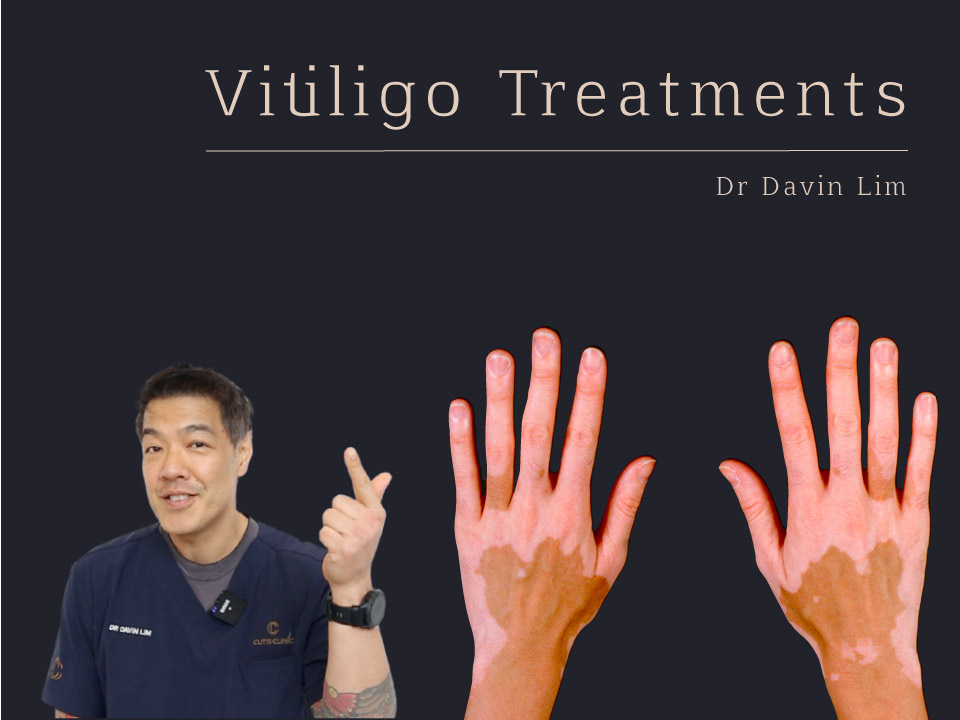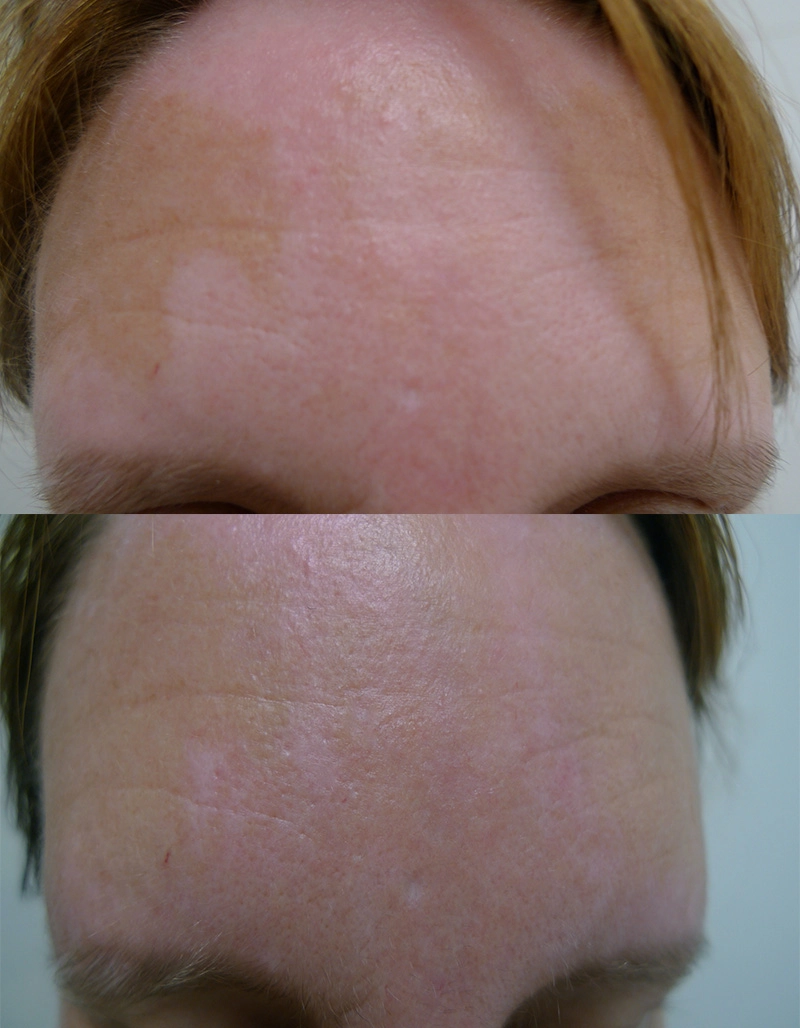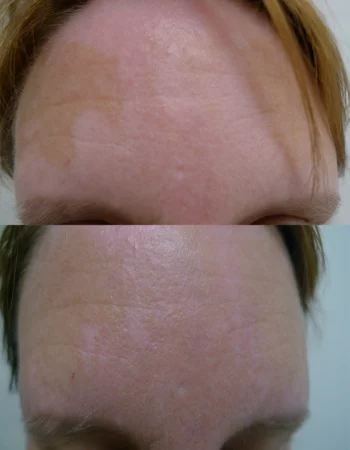With specialist management, we can repigment vitiligo in 90% of cases. Dermatologists use creams, prescribed phototherapy, dietary supplements & in resistant cases, surgery to treat vitiligo effectively & safely. Most treatments are covered under Medicare.
Learn more about our vitiligo treatments:
- Vitiligo Phototherapy
- Narrowband Phototherapy
- 白癜风手术
Treatments for Vitiligo
Phototherapy & topical creams are the key to re-pigmentation
Dermatologists can assist you repigment your skin
Combining topical creams with medically prescribed phototherapy can give fast results. Some patients notice changes as early as 2 weeks. Full repigmentation may take several months. Phototherapy is considered as a necessary step to awaken pigment cells to re-colour vitiligo skin.
With specialist management, we can repigment vitiligo in 90% of cases. Dermatologists use creams, prescribed phototherapy, dietary supplements & in resistant cases, surgery to treat vitiligo effectively & safely. Most treatments are covered under Medicare.
The power of light therapy
Diet & vitiligo
Narrowband Phototherapy has revolutionized vitiligo treatment. We can re-pigment over 90% of cases with fast results. All treatments are covered by Medicare.
Though the evidence of dietary associations are weak, patients can try a diet high in antioxidants & low in pro-inflammatory food groups. Antioxidant foods include nuts, green leafy vegetables & fish. Pro-inflammatory foods include citrus fruits & tomatoes.
With specialist management, we can repigment vitiligo in 90% of cases. Dermatologists use creams, phototherapy, dietary supplements & in resistant cases, surgery to treat vitiligo effectively & safely. Most treatments are covered under Medicare.
常见问题
What is our success rate?
Up to 85%. But it is dependent on site & duration of vitiligo. As a guide
- Facial areas: 80-90%. Lower if the lip is involved.
- Truncal & upper limbs: 70%
- Acral, hands & feet: 15%
An important clue as to whether your vitiligo will respond to treatment is the presence of pigmented hair follicles. The more pigment in your hair follicles, the higher the success rate.
How do we treat vitiligo?
Dermatologists at Cutis have over 20 years of experience in the management of vitiligo.
We employ a combination of:
- Creams: include anti-inflammatory medications.
- Phototherapy: to stimulate the migration of pigment cells & reduce inflammation.
- Diet & supplements: to reduce inflammation.
- Surgery: as last line therapy in resistant cases.
- Lasers: as part of continued research.
Learn more (link to vitiligo phototherapy in this section)
What creams do we use?
Creams are one of the most common methods we use, often in combination with phototherapy.
Creams function to reduce skin inflammation & to stimulate the migration of pigment cells. The ingredients include-
- Anti-inflammatory CS ointments
- Prostaglandin analogues
- Calcineurin inhibitors
- Vitamin D
Creams cost less than $1.90 a day, most are covered under the PBS, costing less than $5 per tube.
What is narrowband phototherapy & why is it important?
Narrowband phototherapy stimulates the pigment cells hiding in your hair follicle to migrate & produce more melanin. This accounts for repigmentation.
It also reduces inflammation in your skin & preserves the remaining pigment cells.
Phototherapy is painless & takes between 1 to 3 minutes to perform. 2-4 sessions are conducted over a week.
Learn more (link to vitiligo phototherapy in this section)
How many sessions of narrowband phototherapy will I need?
Results can be seen within a few weeks; however you will need at least 20 weeks of phototherapy for optimal outcomes. Based upon the result, your dermatologist will optimize the treatments.
How does medically prescribed phototherapy differ from sunlight?
Phototherapy is medically prescribed light using one wavelength. Narrowband filters out the other spectrums found in sunlight, making treatments safer & more effective.
The 311 narrowband wavelength is optimal for suppressing inflammation & at the same time stimulating pigment production.
How much are vitiligo treatments?
Medicare subsidizes vitiligo therapy up to the sum of $7,900 annually.
Treatments are bulk billed if you have a Medicare card.
As a guide-
- Phototherapy – no charge.
- Topical creams- approximately $1.90 per day.
- Supplements- approximately $1.20 per day.
Some creams are available on the PBS, meaning one tube costs approximately $5.
If you do not hold a Medicare card, you will need to clarify if phototherapy is covered under medical insurance.
What causes vitiligo?
Vitiligo is an autoimmune disease & is due to your immune system destroying pigment cells.
It is thought to be genetically determined & made worse with factors such as stress, infections, trauma & in some cases pro-inflammatory foods.
Vitiligo affecting the skin is akin to diabetes affecting the pancreas, thyroid antibodies to the thyroid gland, & pernicious anaemia.
On this basis, you should have an annual check-up with your doctor to monitor hormone & blood indices as described above.
What types of vitiligo don’t respond well to therapy?
Understanding prognosis is important. We will discuss your chances of success, based upon examination & history, Negative factors include-
- Segmental vitiligo. This type responds poorly to medical therapy but responds well to surgery.
- Poliosis or white hairs. FUE transfer can be very effective.
- Acral vitiligo: Hands & feet have a 10-15% chance of repigmentation.
- Vitiligo with no pigmented follicular units: The reserve of pigment cells are in follicles.
How do we treat vitiligo in children?
Treatment depends on the type of vitiligo. For example, segmental vitiligo, progressive depigmentation & poliosis are managed differently. We also consider the age of the child.
- Creams are safe & effective in over 80% of facial vitiligo.
- Narrowband UVB can be performed on children over the age of 6.
- Surgery is not indicated in children less than 15.
The exact program will be discussed with you in detail during the consultation with your dermatologist.
What types of surgery do we perform?
Surgery is the last line treatment. We are experienced in all types of surgery including micrografting, split grafts, punch grafts, FUE & ReCell.
The treatment of choice is free hand ultra-thin split micrografting. This has the fastest results, covers the greatest area & offers the most natural outcomes.
Surgery is not performed in Kobner vitiligo, unstable disease, young children, & patients who have not trialled medical therapy.
What to consider prior to commencing vitiligo treatments?
Treating vitiligo requires motivation & compliance. Our dermatologists will find the best, safest & most cost effective solutions to help you re-pigment skin. Consider-
Compliance: Creams are safe, effective & don’t cost much. Applying topicals will help, so don’t forget to do so.
Phototherapy: this treatment is under Medicare, so the only thing it will cost you is time. It takes 2-3 minutes to perform, but you do require between 1-4 sessions per week (average 2.8).
Probability: Repigmentation is best on the face, & lowest on acral sites such as the feet & hands.
Time frame: With creams & narrowband, we can expect results in the first few weeks of treatment, but it can take 6 months or longer to ascertain progress.
Surgery: is only contemplated if you fail medical therapy.
Medicare & insurance: Medicare covers phototherapy sessions (up to $7,900 annually), if you do not have Medicare clarify phototherapy with your insurance company.
Can diet help?
Diet is controversial; however, we believe that they can help you psychologically, besides, dieting will reduce body fat & has many health benefits hence it’s encouraged.
Consume foods rich in antioxidants. They include:
- Vegetables
- Fruits
- Nuts
- Fish
A good rule of thumb for eating enough antioxidants is to eat as many different coloured fruit and vegetables as possible.
Avoid Inflammatory foods including:
- processed meats
- Carbonated drinks
- saturated fats, found in fried foods
- white bread
- gluten
- soybean oil & vegetable oil, use olive oil instead
- processed & refined foods
- alcohol
- excessive carbohydrates
补充剂能帮上忙吗?
There is some evidence that ginkgo biloba supplements can help. This can be obtained from a health food shop. Oral vitamin D tablets have also been reported. Green tea is a potent antioxidant & can, in theory reduce oxidative stress.
Topical antioxidants include tocopherol & ferulic acid. Though vitamin C is one of the most potent antioxidants, do not put it on vitiligo areas as it also suppresses the formation of pigment.
These antioxidants can reduce photodamage & are harmless.
What types of lasers can treat vitiligo?
The two lasers’ dermatologists use to treat vitiligo are excimer 308 & fractional lasers.
Excimer 308 lasers: can be more effective than phototherapy, especially in treating smaller areas.
The downside of Excimer laser is the cost as each treatment cost over $200 with no Medicare rebate. Most patients require 20-30 sessions.
Fractional lasers: Destroy abnormal cells & encourage pigment production & migration of stem cells from the hair follicles. It is successful in about 5% of patients. It’ use is experimental & not mainstream. Our dermatologists perform 2 to 3 cases a year based upon the low success rate of this treatment.
How can white hairs be treated?
White hair is due to lack of pigment cells in the hair follicles. This type of vitiligo is referred to as poliosis. It can be notoriously difficult to treat.
FUE or follicular unit extraction is the best method. This involves transferring hair follicles from an area with pigment to the affected area. It is not under Medicare & cost between $1900 to $3500 a session.
Microneedling with PG analogues can be successful in 10-15% of cases. You will need 3-5 sessions. Lasers can also give marginal improvements & can be successful in less than 10% of trials.
What DIY treatments are there?
DIY vitiligo treatments are not encouraged as Medicare entitles patients to effective, safe & cost-effective treatments. They can be considered if you do not have medical insurance. You do not need to see a dermatologist for these treatments, as by law we cannot supervise DIY/home remedies.
Psoralen +UV therapy can be used, it’s popular in the Middle East. We do not prescribe psoralens for vitiligo in Australia.
Microneedling + topicals including pseudo catalase, anti-inflammatory & pigment stimulators.
UVB home use: Home have low power outputs are not calibrated. Safety issues are a concern. Prescription narrowband is faster, safer & more effective.
Prescription creams: can be sourced from India & Canada online.








